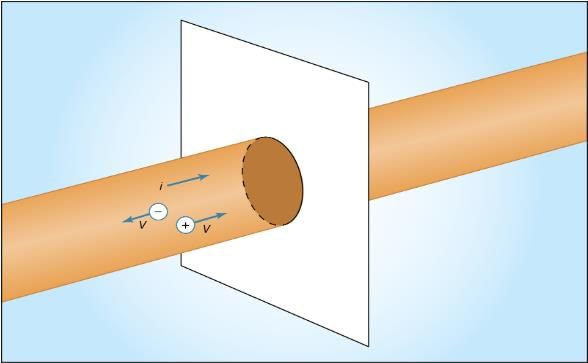Basic Phenomena and Principles | Additional Documents & Tests for IIT JAM PDF Download
Many electric phenomena occur under what is termed steady-state conditions. This means that such electric quantities as current, voltage, and charge distributions are not affected by the passage of time. For instance, because the current through a filament inside a car headlight does not change with time, the brightness of the headlight remains constant. An example of a nonsteady-state situation is the flow of charge between two conductors that are connected by a thin conducting wire and that initially have an equal but opposite charge. As current flows from the positively charged conductor to the negatively charged one, the charges on both conductors decrease with time, as does the potential difference between the conductors. The current therefore also decreases with time and eventually ceases when the conductors are discharged.
In an electric circuit under steady-state conditions, the flow of charge does not change with time and the charge distribution stays the same. Since charge flows from one location to another, there must be some mechanism to keep the charge distribution constant. In turn, the values of the electric potentials remain unaltered with time. Any device capable of keeping the potentials of electrodes unchanged as charge flows from one electrode to another is called a source of electromotive force, or simply an emf.
Figure shows a wire made of a conducting material such as copper. By some external means, an electric field is established inside the wire in a direction along its length. The electrons that are free to move will gain some speed. Since they have a negative charge, they move in the direction opposite that of the electric field. The current i is defined to have a positive value in the direction of flow of positive charges. If the moving charges that constitute the current i in a wire are electrons, the current is a positive number when it is in a direction opposite to the motion of the negatively charged electrons. (If the direction of motion of the electrons were also chosen to be the direction of a current, the current would have a negative value.) The current is the amount of charge crossing a plane transverse to the wire per unit time—i.e., in a period of one second. If there are n free particles of charge q per unit volume with average velocity v and the cross-sectional area of the wire is A, the current i, in elementary calculus notation, is

Figure : Motion of charge in electric current i (see text).
 (15)
(15)
where dQ is the amount of charge that crosses the plane in a time interval dt. The unit of current is the ampere (A); one ampere equals one coulomb per second. A useful quantity related to the flow of charge is current density, the flow of current per unit area. Symbolized by J, it has a magnitude of i/A and is measured in amperes per square metre.
Wires of different materials have different current densities for a given value of the electric field E; for many materials, the current density is directly proportional to the electric field. This behaviour is represented by Ohm’s law: (16)
(16)
The proportionality constant σJ is the conductivity of the material. In a metallic conductor, the charge carriers are electrons and, under the influence of an external electric field, they acquire some average drift velocity in the direction opposite the field. In conductors of this variety, the drift velocity is limited by collisions, which heat the conductor.
If the wire in Figure has a length l and area A and if an electric potential difference of V is maintained between the ends of the wire, a current i will flow in the wire. The electric field E in the wire has a magnitude V/l. The equation for the current, using Ohm’s law, is
 (17)
(17)
Or
 (18)
(18)
The quantity l/σJA, which depends on both the shape and material of the wire, is called the resistance R of the wire. Resistance is measured in ohms(Ω). The equation for resistance,
 (19)
(19)
is often written as
 (20)
(20)
where ρ is the resistivity of the material and is simply 1/σJ. The geometric aspects of resistance in equation (20) are easy to appreciate: the longer the wire, the greater the resistance to the flow of charge. A greater cross-sectional area results in a smaller resistance to the flow.
 (20)
(20)
The resistive strain gauge is an important application of equation (20). Strain, δl/l, is the fractional change in the length of a body under stress, where δl is the change of length and l is the length. The strain gaugeconsists of a thin wire or narrow strip of a metallic conductor such as constantan, an alloy of nickel and copper. A strain changes the resistance because the length, area, and resistivity of the conductor change. In constantan, the fractional change in resistance δR/R is directly proportional to the strain with a proportionality constant of approximately 2.
A common form of Ohm’s law is
V=iR (21)
where V is the potential difference in volts between the two ends of an element with an electric resistance of R ohms and where i is the current through that element.
Table 2 lists the resistivities of certain materials at room temperature. These values depend to some extent on temperature; therefore, in applications where the temperature is very different from room temperature, the proper values of resistivities must be used to calculate the resistance. As an example, equation (20) shows that a copper wire 59 metres long and with a cross-sectional area of one square millimetre has an electric resistance of one ohm at room temperature.


|
Explore Courses for IIT JAM exam
|

|

















